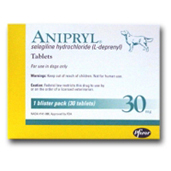Cushing's disease, or hyperadrenocorticism, is caused by the presence of too much of the hormone cortisol or less commonly other hormones circulating throughout your dog's body. Cortisol is primarily produced by the adrenal glands. Overproduction of cortisol most typically occurs when a tumor in the pituitary gland over stimulates the adrenal glands or by a hormone-secreting tumor within an adrenal gland itself.
In some cases, the overuse of corticosteroid drugs can also lead to Cushing's disease. Middle-aged to older dogs are most frequently diagnosed with hyperadrenocorticism. This condition is the opposite of Addison's disease, or hypoadrenocorticism.
"If you think your dog has Cushing's disease, take him to the veterinarian."
The Signs of Cushing's Disease
Cortisol is a stress hormone. It is
very useful during short periods of high stress, but when the body is
constantly bathed in cortisol, problems start to develop. Typical
symptoms of Cushing's disease include:
- Increased appetite
- Increased thirst and urination
- Poor coat quality
- Skin problems
- Recurrent infections
- Panting
- Muscle weakness
- A pot-bellied appearance
Cushing's Disease Veterinary and Home Care
If you think your dog has Cushing's
disease, take him to the veterinarian. Routine blood work and
urine testing may support the diagnosis and help rule out other diseases
that cause similar symptoms, but one or more specific laboratory tests
(e.g., an ACTH stimulation test or low dose dexamethasone suppression
test) and possibly an abdominal ultrasound will have to be run to reach
a definitive diagnosis and to determine what the underlying cause of
the disorder is.

If an adrenal tumor is to blame, surgically
removing the affected adrenal gland may be possible, which effectively
cures a dog of the disease. The pituitary gland is surrounded
by the brain, which makes removing or destroying tumors in this area
more challenging. Therefore, dogs with the pituitary form of the
disease are usually treated with one of several different pet medications like Anipryl (selegiline) or drug combinations that suppress adrenal
function. Life-long therapy is necessary in these cases, and dogs must
be closely monitored for potential side effects of treatment.
If a
dog being treated with corticosteroids develops the symptoms of Cushing's
disease, he will need to be slowly tapered off of these medications.
Hyperadrenocorticism is a potentially
fatal disease, but with appropriate treatment, many affected dogs can
go on to live long and happy lives.
The above is provided for information purposes only and should not be used for the diagnosis or treatment of any condition.
This information does not cover all possible variables, conditions, reactions, or risks relating to any topic, medication, or product and should not
be considered complete. Certain products or medications may have risks and you should always consult your local veterinarian concerning the treatment of
your pet. Any trademarks are the property of their respective owners.